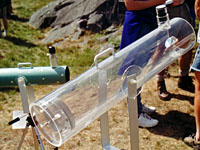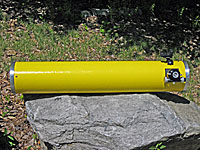

Build a Newtonian OTA

In this section we will show you how to build a Newtonian Optical Tube assembly, one of two major subassemblies for building a small Dobsonian telescope. However, you could also use this OTA on another type of mount if you build a suitable adapter (Cradle or Rings, and you might find our Tube Cradle in the Mount section to be quite adaptable). This design is suitable for mirror diameters in the 4-inch to 12-inch range, although 12-inch is pushing it a bit and you might consider a truss tube design for this size (which we will not describe).
The Newtonian design is very popular, because it is simple to make and you get the most aperture per dollar. With the eyepiece near the front end of the tube, it is ideal for a Dobsonian mount.
The characteristics of the primary mirror you will use determine many things in constructing your OTA. If you have an existing primary mirror for this project, as we do, many choices in designing your telescope have already been made. If you need to obtain a primary mirror, then you have choices to make.
A primary mirror for a Newtonian has a parabolic surface with three key parameters: Mirror Diameter, Focal Length, and Focal Ratio. These three parameters are related by the following formula, and hence often only two of the three are specified:
Focal Length = Mirror Diameter x Focal Ratio
Therefore, a 6-inch f/8 has a 48-inch focal length. The focal length is the major determent of your telescope's overall length, which is a key factor in its ability to be transported. If you intend to move your telescope about in a compact car, keeping the tube length to about 48 inches or under is a good design guideline, as it should fit in most back seats at this dimension.
Mirror Diameter is the other key parameter. Larger mirrors gather more light, let you see fainter objects, and have higher resolution. However, large mirrors cost more, are heavier, and take longer to cool down to present steady views when you start your observing session.
You might want to read our article about Selecting a Telescope. You can explore and compare telescopes with various parameters using our interactive Telescope Formulas and Design Comparator. If you are not making your own mirror, you can ignore the results in the output section titled 'Mirror Parameters' - all the other sections apply to designing your own telescope.

Remember that purchased primary mirrors generally come in only certain diameters (4, 6, 8, 10 and 12 inches) and popular focal ratios ( f/6, f/8, and to a lesser extent f/5, f/4, f/10). You might want to look at what is offered for purchase from vendors on our Links Page under Suppliers. You want a Full Thickness mirror, because the basic mirror cell we are building will not support a Thin Mirror. Usually mirrors 8-inches and under are full thickness, 10 and above are supplied in either style.
If all this information gives you a headache and you want some standard advice, the two most popular Dobsonian sizes are 8-inch f/6 and 6-inch f/8, both of which are good, general purpose telescopes in manageable sizes.
Once you settle on your primary mirror parameters, there are a host of other subsidiary design details, which we will cover in the next section, Designing Your Telescope.
Next: Designing Your
Telescope
Back to the Build a Dobsonian Master
Index